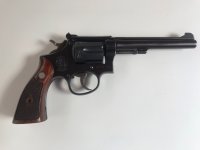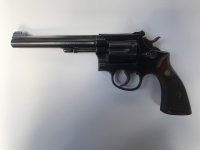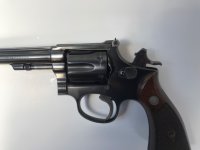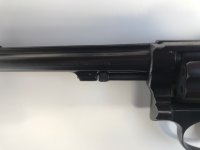After taking pictures of some post war M&P's for another member I noticed that the early 1948 S prefix short action had the knurled rod instead of the barrel type. Was this change made in conjunction with the switch to the short action hammer?
So to make it abundantly clear, the short answer is no, there is no correlation between the barrel knob rod usage to S&W's change to the "Speed Lock" action (the short action) in any K or N frame models.
But close, only separated by 6 months for the 38 K frame as Jack posted above.
The change to the Speed Lock is one of few cases when there was little to no transition period, like the new PW hammer block safety. While the rod change was strung out sporadically over a long time like most S&W minor changes that depended on exhausting the old part supplies.
The only correlation to the Speed Lock action introduction are of course the four early high speed hammer styles: K target (fishhook), K fixed sight/N fixed sight (same style, diff size), and N med. target which continues to this day on all N models if the .500" 'full' target hammer is not substituted.
The K frame K22 "Speed Lock" action guns began with the K22/40 2nd Model/1st Model Masterpiece in 1940. Therefore when re-introduced after the war in 1946 as the K22 2nd Model Masterpiece beginning in its own serial # range at K101, (there is no PW Transitional K22 model), which can be referred to as the Model of 1946, and 1st Pre Model 17.
Similar to the way the K38 w/Speed Lock action began April 1948 at #S990184 (soon to start over at C1 the same year), can be referred to as the Model of 1948. and 1st Pre Model 10.
Or the way N frames with Speed Lock action are referred to as the Models of 1950, 1st pre Model 20, 21, 22, 23, 24, 25. 26, and 27. The Pre Model 28 came in 1956.
Note: The post war I frame did not receive the "Speed Lock" action. The completion of post war changes to the I frames are known as the Models of 1953.




